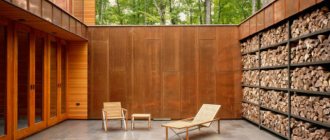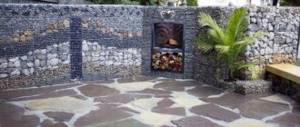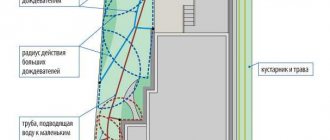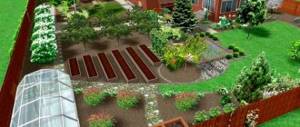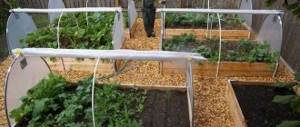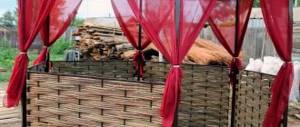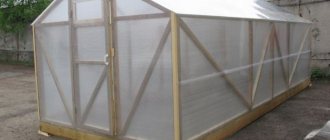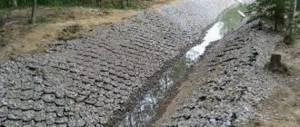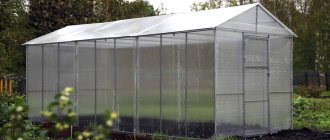Rockery and rock garden: similarities and differences
Stone garden
The first rock gardens appeared in Southeast Asia; every detail in the Chinese and Japanese garden was not accidental and had philosophical significance. In Europe, stone flower beds spread in the second half of the 18th century. Every year, rockeries and rock gardens - areas on which various compositions using stones and plants are made - are becoming more and more popular all over the world.
- rock gardens reproduce the mountainous alpine landscape in miniature, therefore they are created in the form of rocky hills. Rockeries can also be placed on a flat surface
- In a classic rock garden, plants growing on mountain slopes are planted. Dwarf conifers and ornamental shrubs, which are not found in nature in such a combination, are popular for landscaping rockeries.
- sunny places are selected for rock gardens; the rock garden can also be located in the shaded part of the garden plot
- when creating a rock garden, more stones are used than in rock gardens
In both types of rocky gardens, slow-growing, unpretentious species are preferred.
Externally, the rock garden resembles a rock garden. But these flower beds still have differences:
- Location. Alpine slides are organized on natural slopes, and any landscape (including plain) is suitable for rock gardens.
- Plants. When creating a rock garden, you need to choose exactly alpine plants, and the composition for a rock garden can contain any plants (annual and perennial), evergreen conifers, etc. The main thing is that they combine well with each other.
In addition, in a rock garden, the dominant role is given to plants. There may be stones there, but there should not be too many of them. And in the design of rockeries, rocky surfaces come to the fore, among which attractive plants can be seen.
On the left is a rock garden, on the right is a rock garden
Benefits of rock garden
Rockery in landscape design
The main advantage compared to a rock garden is the use of not only alpine species that grow poorly in the middle zone. For rockeries, the variety of plants is much higher, they are less demanding on the soil, often have a powerful root system, and are easier to care for. There is also no labor-intensive construction of a slide; a flat rock garden is not subject to soil washing out and stones sliding.
Unlike flower beds, rockeries look impressive, natural and perfectly decorate problem areas of the dacha - barren areas and blind areas of buildings. A rocky flower garden will not only decorate the garden, but also help protect the soil from erosion.
Which stones to choose
Based on the description of the rock garden, the stones will become its main part. Due to this feature, it is necessary to choose the right building material. You will also need to place it correctly in the selected area. Without a combination of these two rules, it will not be possible to create a beautiful design composition. After all, even if you have the most beautiful flowers, it will turn into an ordinary flower bed.
We also recommend learning how to beautifully plant tulips and daffodils on your site.
The selected natural stone should be approximately the same shape and size. Large boulders are perfectly complemented by small placers. The main condition for their placement will be naturalness, in other words, merging with the surrounding landscape. Accordingly, the material is selected based on the location and size of the future rock garden. If it is near a body of water, you should choose smooth, naturally polished stones. Otherwise, if the flower garden is far from water, then choose a pointed building material, as it will resemble a peculiar mountain or plain look.
One of the most important conditions is the lack of great diversity. Different minerals should not be used in one design. In most cases, 2-3 stones are enough to create a semblance of a natural landscape. In addition, they do not allow the usual dumping of cobblestones, as in a quarry. Strict adherence to forms and smooth lines are the key to a beautiful and natural rock garden.
Check out ways to use tree stumps in landscaping.
One of the important factors in choosing stones is their structure. After all, it can change under the influence of different weather conditions. Limestone and sandstone, absorbing moisture, often change their color. Granite and marble are suitable for creating a permanent backdrop. Experts advise choosing no more than three different colors.
At the same time, it is recommended to abandon gray shades, as they will get lost among the greenery and bright colors of flowering plants.
Recommendations for building a rock garden
If you look at a photo of a rock garden, you will notice that its construction requires great skill and skill. We want to tell you about the most popular mistakes, knowing which you can prevent inconvenience during the installation of a rock garden.
Amount of moisture
Carefully monitor the amount of moisture in the soil on which the rockery will be installed. But it’s also not worth installing rockeries in too dry soil, as this can negatively affect the plants that will grow in this area.
If you have not found the optimal place to install a rock garden, you can fill the area with soil that absorbs moisture well. This will help make the rockery area less humid.
External factors
In addition to soil, other external factors and pathogens can interfere with the growth of rockeries. One of these are shrews and moles, which can periodically eat plants and interfere with their optimal growth and development.
Weeds are also very unpleasant for your flower garden.
The fact is that it is already difficult to care for flowers growing on the territory of a rock garden, and if you also turn your attention to weeds that will in every possible way interfere with the growth of plants, it will take a lot of time and effort.
But, fortunately, you can protect yourself from weed germination. To do this, before planting the plants, you need to cover the soil with a special protective layer.
Subsidence of stones
This threat will first of all affect the appearance of your rock garden, making it very sloppy and ugly.
Here are the main mistakes, avoiding which, you will make a good rock garden with your own hands.
Small architectural forms for rock gardens
Small architectural form (SAF) are special structures that have different shapes and sizes. They are installed for the purpose of variety and decoration of the garden area. In addition to its aesthetic function, such an element can become practical. With its help you can protect the space.
Important! It is not recommended to create a rock garden very close to large buildings. Its composition can be disrupted by streams of melted snow.
These elements most often become:
- children's swings;
- mini-pools;
- benches;
- horizontal bars;
- stairs;
- arches;
- pergolas;
- bridges;
- figurines or statues of animals;
- sculptures;
- fences and fences;
- flowerpots and tubs;
- furniture;
- alcove;
- belvedere, which is created with enough free space.
In addition to them, you can supplement the rockery with artificial lighting. A small ground lantern will serve as a backlight in the dark. And large, tall lamps on poles will illuminate not only the structure itself, but also the surrounding area.
Types and styles
Rockery device
- Stable ones require greater thoroughness during construction. Large stones are dug deep into the soil. Perennial plants are chosen and the crown is regularly given the desired shape
- Changeable rockeries are more dynamic and better suited for experimentation. They are made from small stones. Each year, different types of flowers are combined with a base of low-growing trees and shrubs, and new ornamental plants are planted.
Let's look at the main styles of rockeries: Japanese, European, English and tropical.
Types of rockeries
All existing versions of stone gardens are conventionally divided into types that take into account the shape, size and style of the rock garden.
The use of rockeries for landscape decoration involves various forms.
Flat. A piece of land with a perfectly flat surface is suitable for its arrangement. Small differences in height can be leveled out using bedding. As a rule, large areas are used for flat stone gardens.
A flat-shaped rock garden is ideal for arranging large areas with flat terrain
Slide. This form of rock garden is arranged according to the principle of a rock garden. You can choose any height, as well as any angle of inclination. This will depend on the number of stones, their varieties and sizes.
A rock garden in the shape of a slide is close in style to a rock garden, but the choice of plants for it is wider
Wall. This form is used to divide a site into zones. Stone supports look very advantageous, the main function of which is to prevent the soil from crumbling and serve as the basis for an exquisite composition.
This rock garden is ideal for dividing an uneven area into multi-level zones
To arrange rockeries, as a rule, choose sunny places where light-loving plants are planted. If there is no suitable site on your personal plot, it is preferable to choose vegetation that feels good in shade or partial shade.
Size
The area of the rock garden depends on the size of the plot on which it is decided to arrange a stone garden. In a small dacha, you can allocate a site for it and arrange a recreation area on it. For this, Japanese or Italian style is best suited, where resting places are provided - stone and forged benches.
Rock garden equipped for relaxation
If there is plenty of space in the garden, any style and any size will do.
We suggest you familiarize yourself with How to assemble a mini tractor with your own hands, drawings and diagrams. We make a mini tractor with our own hands.
The filling of the rock garden is determined by the style, which allows you to optimally fit the selected elements into the landscape design.
Japanese. A rock garden where the whole atmosphere is literally imbued with the traditions of the land of the rising sun. This does not mean at all that dull, monotonous something awaits guests at the site, decorated in Japanese style. This style welcomes practicality and functionality - furniture, potted plants, lighting and other decorative elements.
Japanese rock garden - the choice of connoisseurs of minimalism
English. Unlike a Japanese stone garden, a rock garden made in the style of the nature of Foggy Albion is characterized by an abundance of greenery. Most often these are coniferous plants, supplemented with wormwood and cereals. Discreet classic.
An English-style rockery will fit harmoniously into the overall picture of a personal plot with a stone house and a fence
Alpine. A style reminiscent of a classic alpine slide, the characteristic feature of which is a selection of flowers and shrubs growing in the Alps. The style also involves the use of artificial waterfalls.
Alpine-style rockery abounds in mountain plants
Italian. A rockery in this style is in many ways reminiscent of an alpine one. The same plants are used here, but in addition to stones and flowers, the overall look is complemented by elegant sculptures and forged elements with smooth lines.
Italian style implies the presence of flowerpots, statues and forging in the composition
European. It mostly uses midland vegetation. As a rule, these are low-growing shrubs and ground cover plants. Also in European rock gardens you can often find compositions of flowers and shrubs that smoothly replace each other throughout the warm season.
A distinctive feature of the European style in rock gardens is plants blooming throughout the entire summer season.
German. This style differs from the European style in the severity of its lines. Instead of natural-shaped boulders, massive structures made of natural processed stone are used here. German style is the embodiment of conciseness, functionality and a pedantic approach to the design of every detail.
The calling card of a rock garden made in the German style is strict precision of lines and thoroughness in every detail
When looking at a German stone garden, you get the impression that every pebble and every plant here is laid out and planted strictly under a ruler. If water is present in the design, then instead of a multi-level stream there is one perfectly smooth waterfall, the artificial origin of which is simply impossible to doubt. The Germans pay special attention to plant health, so most often in rockeries you can find well-leafed trees with straight trunks.
A coniferous composition located in a quiet corner near the foundation of the house is a solution for small spaces
An interesting solution - a rock garden at the exit from the terrace
The composition of stones and low-growing plants fits harmoniously into the overall picture of the recreation area
Mixing styles gives a certain zest
A rock garden on a small plot near the house with panoramic windows refreshes the overall look
A relatively small rockery on the edge of the site adds mystery to the property
To avoid any unforeseen situations like “something went wrong” in the process of creating a rock garden, it is better to draw up a plan or diagram of the future rock garden before starting work.
Design option in which the rock garden is arranged in combination with a flower garden
Successful examples of design solutions for small areas
Option for arranging a “dry stream” rock garden with coniferous plantings
Of course, there are many types of rockeries. We will present to you the main types that are used most often.
European rock garden. Quite an ordinary, standard rock garden. It got its name because of the plants that are used for this rockery. To get such a flower garden, you need to use plants that grow in the middle zone.
English rockery. This rock garden is already more interesting. It differs in that in the design of this rockery you need to calculate everything as accurately as possible, because any mistake can cause failure. Usually, they try to fill such a flower garden with greenery as much as possible.
Japanese rock garden. This look is classic. This is what is meant by the most ordinary rock garden. The basis is stones of different sizes and shapes. Regarding plants, there are no special recommendations, use according to your taste.
Rockery styles
There are several styles of designing rockeries and each gardener can choose the option that he likes best.
Japanese style places emphasis on the compositional arrangement of stones. Various types of mosses, rarely conifers, are used, which border a “dry stream” of scattered stones, simulating living water.
The English style consists of conifers and a small amount of cereals, a kind of minimalism to create the impression of a natural coniferous forest.
The German style is a strict, linear planting of plants and the use of not only natural, but also processed stones. Plant groups of unpretentious flowers and lush low-growing shrubs are used.
The tropical style is not developed in Russia due to the lack of natural exotic plants.
European style is a classic version that combines all the elements of vegetation. Usually this is a colorful and rich in colors and types of rockeries.
Choosing plants for a rock garden is not so difficult - the choice is more than wide enough:
1. At the top of the list are, of course, miniature conifers, without which almost no rockery can do. The essential oils released by the needles give the area a magical smell of the forest.
2. In second place are small deciduous shrubs: decorative-leaved and beautifully flowering.
3. Well, of course, one cannot do without perennial plants, especially ground cover.
4. You can also see bulbous ones in rockeries, although they are not used so often.
If your garden is located on a flat, open area, well lit by the sun, then there is no problem at all with the choice. But for shady places you will have to spend more time searching and selecting.
The only limitation is the height of the plants. For example, on a completely “flat” rock garden, plants are planted, as a rule, no higher than 50-60 cm. Otherwise, the integrity of the perception of the composition is violated. For “hilly” stone gardens the bar is slightly higher – a height of up to 1-1.5 m.
Selecting plants
Plants in rock gardens
Dwarf varieties of conifers, decorative deciduous and flowering shrubs, perennial herbs and flowers, and ground cover are suitable for planting in stone flower beds. Less commonly used for decoration are bulbous plants (tulips, hyacinths, daffodils).
Coniferous species
Composition with juniper
Coniferous species When selecting plants for a rock garden, coniferous species are popular: miniature varieties of cypresses, pines, spruces, hemlocks, junipers, fir trees.
Varieties commonly used for planting include:
- mountain pine (Pinus mugo) – Mops, Gnom and Winter Gold
- horizontal juniper (Juniperus horizontalis) - Wiltonii and Blue Moon
- leaning juniper (Juniperus procumbens) – Nana
- juniper (Juniperus squamata) – Blue Carpet, Blue Star
- Thuja occidentalis - Danica, Teddy, Ellwangeriana Aurea
- Canadian hemlock (Tsuga canadensis) - Bennett, Gracilis Oldenburg, Minima
- cypress (Chamaecyparis)
- Norway spruce (Picea abies) - Nidiformis
- Korean fir (Abies koreana) – Brillant, Alpin Star
Choose species with richly colored needles and an interesting shape.
Deciduous plants
Barberry in landscape design
Deciduous plants Present in the form of shrubs and dwarf trees.
Often used:
- cotoneaster horizontalis
- honeysuckle (Lonicera pileata)
- Japanese spirea (Spiraea japonica)
- Thunberg's barberry (Berberis thunbergii)
- creeping willow (Salix repens)
Plants for a stone garden
Perennial herbs and flowers, cereals and ground cover species. Perennial herbs and flowers will decorate the rockery - primrose, geranium, petunia, crocuses, yarrow, hosta, irises, delphinium, lavender, daylily, lumbago, immortelle, St. John's wort, gypsophila, etc.
Cereals include fescue, barley, feather grass, bluegrass, and millet.
Mandatory plants in rock gardens that create a fluffy layer are plantings of ground cover perennials. These include: sedum, subulate phlox, aubriettes, arabis, saxifrage, etc.
We invite you to familiarize yourself with How to pack a New Year's gift with your own hands?
Important points to consider:
- choose slow-growing, unpretentious species
- plant height for medium-sized areas is no more than 1 m, for small ones up to 0.5 m
- To maintain year-round decorativeness, the frequency of flowering is taken into account. Some flowers are planted in separate flowerpots or flowerpots
- in classic versions, only perennial plants are used
- For a shaded garden, moisture-loving species are suitable: wood sorrel, oxalis, primula, buttercups and ferns. For sunny days - wormwood, edelweiss, armeria, thyme
- take into account the needs of plants for light, moisture, soil composition
- Before planting plants, they think through the color scheme, combination of shapes and textures
The main factor considering which rockeries are used in landscape design are stones. They create the main beauty of this flower garden. That is why their choice is very important.
So, we present you with basic recommendations for choosing good stones for your rock garden.
Durability. The most important parameter, because it determines how long your rock garden will serve you.
Besides the fact that this stone is quite durable, it also looks pretty good. This can have a positive effect on the appearance of your rock garden.
Decorative. The appearance of your rockery is also very important, because it is precisely because of its unusual appearance that the rockery is so popular. Here we will advise you to choose stones such as sandstone and granite.
The right choice of plants is also very important for a good rock garden. There are several rules for choosing plants for rockeries. We will present you with the basic rules for choosing flowers and greenery.
We do not advise you to choose plants that bloom and look beautiful only at a certain period of time. Since rockeries are planted for a long time, plants for them should also be selected that bloom for a long time. As an example, we can give you decorative bows. These plants are perfect for your rock garden.
There is no need to plant plants that grow very quickly. It may happen that the plants are much taller than the stones. This completely destroys the entire appearance of the rockery and will make it look like a hedge.
Therefore, select those plants that grow at an optimal speed and whose growth can be controlled.
Suitable plants
The key rule when arranging a rock garden is to choose vegetation whose height will not exceed 50 cm. During the season, crops should replace each other during the flowering period. More often, plants are chosen that do not need frequent replanting and can remain green during the winter.
Learn how to create blue spruce landscapes.
For a small rock garden, it is recommended to use a maximum of 15 types of vegetation. Initially, you can plant less, and then gradually add more as needed. The most suitable options would be low-growing and ornamental coniferous trees and shrubs, various deciduous crops, ground cover and perennial flowers and herbs.
About 2/3 of the space is allocated for low-creeping species. The rest of the area will be decorated with hardwoods. The most popular plants are raulia, thuja, semolina, fir, and cypress. Among deciduous trees, preference is given to barberry, azalea, and spirea.
Rockery care
An important factor is the care of your rock garden. After all, if you properly care for your flower garden, it will serve you for a very long time.
And so, if the basis of your rock garden is greenery, then it should be watered frequently and thoroughly. For watering, you should use a special spray nozzle so as not to break the plants with a large flow of water.
In addition, you should carefully monitor dying plant leaves.
If you left your rockery for the winter, then you probably lost some frost-resistant plants. During the onset of the summer season, it is worth planting new plants to replace the dead ones.
Periodically check the stones for stability. If the stones begin to stagger and move, then add soil under them to restore them to a stable position.
Only those plants that need it need to be constantly watered and fed. Do not overdo this, otherwise you may oversaturate some plants and they will stop growing evenly.
If your flower garden contains bulbous plants, then their bulbs need to be dug up periodically and checked for suitability. Dead and rotten bulbs need to be removed and new healthy specimens planted in their place.
These are the basic rules for caring for rock gardens, by following which you can maintain the good appearance of your flower garden for many years.
Maintaining order in a stone garden is not difficult. It is enough to provide it with timely care, and the rock garden will always look attractive. There are several nuances that should be given special attention:
- Watering frequency. Entirely depends on the plants chosen for the design. Mountain plants are resistant to dry weather, so natural precipitation will be enough for them. If necessary, you can always organize artificial watering.
- Fertilizers. They are also used according to the type of vegetation.
- Insulation. If you choose a landscape style with heat-loving perennials, you should provide them with reliable shelter for the winter.
- Cleaning. In autumn, it is necessary to remove fallen leaves, seeds, and dry branches from the flowerbed.
- Health. If a diseased plant is found in a rock garden, you need to get rid of it so that the disease does not spread to other crops. The removed bush or flower is replaced with a healthy one, having previously disinfected the planting site with appropriate preparations.
Fertilizers should be used in moderation and strictly according to instructions.
An example of insulating low-growing trees in a rock garden
Winter shelter for heat-loving rock garden residents
The drip irrigation system will facilitate the care of the rock garden in which moisture-loving plants are planted
Composition in pink tones
- Watering is carried out as needed to a depth of 7-8 cm
- rockeries should be weeded, carefully removing weeds; the soil under the plants should be mulched to retain moisture after watering
- Fertilizers are applied only to those plants that need it
- regularly remove dead and dried leaves and inflorescences, and trim overgrown shoots of ground cover species
- new plants are planted in place of dead plants
- check whether the soil has been washed away during rains and snow melting; if this happens, add soil, sand and compact it
Near plants that require neutral or alkaline soil (gypsophila, edelweiss, parsley, lumbago), lime is added to the soil. Caring for rock gardens is not difficult and can be done by a novice gardener. If you follow the basic rules, a stone garden will delight its owner for many years.
How to make a rock garden with your own hands on the site: step-by-step instructions
Installation of curb tape
1 After choosing a place for a rockery, prepare the area - level the area, remove turf (up to 20 cm), excess plantings and weeds
2 Mark the border, dig in, place border tape. The tape is firmly immersed in the soil and compacted on both sides.
3 Geospan, a synthetic textile ideal for landscape work, is placed in the recess for the rock garden. The material is adjusted along the edge of the border strip.
We suggest you read: How many years can a cow give milk?
Laying geospan and placing large stones
4 The next stage is the installation of stones. They start with large boulders, trying to avoid symmetry, clear shapes and figures.
5 Think about the placement of plants, taking into account their further growth, and begin planting. Geotextiles are cut with scissors and the edges are folded. Dig a hole of sufficient size, add a fertile layer - soil, peat, drainage (crushed brick, expanded clay, sand) and other fillers required for each specific type.
Having completed these works, the geospan is folded back and covered with backfill. When planting plants, the order is observed - first, tree species are planted, then shrubs, and finally ground cover varieties.
Planting
6 The next step is to fill it with small stones in a layer of 5 cm. The material is selected based on what stones were used. If the rocks are rubble (dolomite, limestone, sandstone), then it is better to use crushed stone, and if there are round stones, then pebbles.
Filling with stones
7 Upon completion of the work, the composition is complemented with small stones and decorative elements.
Stone garden
8 The surface bordering the garden is covered with lawn - the greenery creates contrast and focuses attention on the rock garden. You can use seeded or rolled lawn.
Creating a rock garden on a summer cottage does not require strict adherence to a certain plan and style. Some things can be taken from one example, some from another. Don't be afraid to combine styles and shapes. The main thing is that the result is not a meaningless pile of stones and plants.
Do-it-yourself rock garden option with a pond in landscape design
The main selection criterion is a site where shrubs and trees do not grow. Everything else is optional: the terrain does not have to be perfectly smooth. Some designers prefer to make artificial hills even on flat areas, using embankments of sand, stones or soil.
Simple rules to follow when choosing a place for a rock garden:
- On a large area, a rocky garden will look better in a recreation area.
- It is undesirable to place a rock garden in close proximity to buildings, since there is a risk of damage to the flower garden by a layer of snow sliding from the roof.
- In those areas where there are already decorations in the form of ponds, fountains or streams with bridges, a rock garden selected to match the overall style would be a good option.
The wall rockery option favorably emphasizes the transition between levels and hides uneven terrain
Mini rock garden comfortably located in a corner of the garden plot
Rock garden option for large areas
A beautiful rockery blends harmoniously with the greenery of the lawn
Rules for arranging a rock garden on a summer cottage
- Draw a rough plan of the rock garden, mark the location of the stones and flower bed.
- Mark the area of the future rock garden. Be sure to remove about 20 cm of the top layer of soil and remove all unnecessary roots and weeds.
- Install a drainage system - a mixture of broken bricks, crushed stone or gravel, then cover it with sand and compact the soil. It will become the basis of the rock garden, rid it of weeds and unnecessary moisture. You should not use as a drainage layer - it will negatively affect future plants.
- The sand on top needs to be covered with a substrate , into which the plants will be planted directly and the stones will be laid. You can prepare the substrate yourself; just mix small crushed stone, garden soil and sand.
- Choose stones of natural shades , then they will be able to highlight the beauty of plants. Remember that large stones look richer and more spectacular than small ones. When installing stones, bury them at least halfway; under pressure, the stones should not turn out or sway.
Since the rockery should look beautiful from all sides, choose an interesting arrangement of stones and turn them outward from the plants.
Try to use stones from the same material, then the composition will look complete. Small stones are fixed with mortar or glue.
